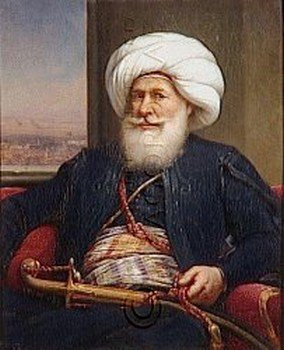Kılıç Ali Paşa also known as Occiali/Uluj Ali 1519/1587
Barbary corsair and restorer of Ottoman naval power after Lepanto. Born Giovan Dionigi Galeni in Le Castella in Calabria, probably about 1520, he was captured by Muslim corsairs as a young man and was a galley slave until he converted to Islam. His name, variously rendered (Uluç Ali, Uluz Ali, Occhialì, Aluchali, Euldj Ali, etc.), means “Ali the Renegade.”
Uluj Ali quickly rose to become a corsair captain in his own right. He participated in the great siege of Malta (1565), succeeding his slain mentor Dragut (Turgut Reis) as governor of Tripoli. From 1568 he was beylerbey, or viceroy, of Algiers, adding Tunis to his domains in January 1570.
In the summer of 1571 he pillaged and burned Rethymnon on Crete before raiding the Dalmatian Islands and causing panic as far away as Venice; his attack on the city of Curzola (Korčula) on 15 August 1571 failed.
At Lepanto he commanded the 93 ships of the Turkish left wing, opposite Gian Andrea Doria, and was the only Turkish commander to emerge from the disaster with his reputation enhanced. The 90 galleys of the Ottoman left under Uluj Ali did not close the League’s right of 57 galleys under Doria but sailed wide to turn its flank. The 2 Venetian galeasses assigned to Doria could not reach their assigned station, so they bombarded the rear of the Ottoman center. Seeing Doria keep pace with him, Uluj Ali turned his wing abruptly and raced for the gap that opened between Doria and Don Juan’s center. The Ottomans overwhelmed 3 galleys of the knights of Malta and savaged 7 galleys of the league vanguard under Juan de Cardona, who had trailed Doria. But the Marquis of Santa Cruz saw Uluj Ali’s maneuver in time and checked the Ottomans with his rear guard until Don Juan and Doria could close to complete the Holy League’s triumph. Although both sides had invoked God, it proved a clear case of God being on the side with more and bigger guns.
Uluj Ali escaped with only 35 galleys, mostly Algerian. The Turks had lost more than 200 galleys and 20,000 people dead. Some 15,000 Christian galley slaves were freed, mostly Greeks who fled into their own country. The allies lost some 7,500 dead, and among the 15,000 wounded was Miguel de Cervantes, author of Don Quixote, who claimed the battle was the most memorable event of all time.
When he returned to Istanbul in December, Selim II renamed him Kiliç Ali (“Ali the Sword”) and appointed him kapudan pasha (grand admiral). In the following months he rebuilt the Ottoman fleet with remarkable speed while improving the design and weaponry of his galleys.
From August to October 1572 he outmaneuvered the Christian commanders along the south coast of the Morea. In 1574 he led the naval armada that captured La Goulette and retook Tunis (briefly held by Spain). He remained kapudan pasha until his death in Istanbul on 21 June 1587. Feared and respected by his Christian adversaries, he is praised by Cervantes in Don Quixote.
References
Beeching, Jack. The Galleys at Lepanto. New York: Charles Scribner’s Sons, 1983. Braudel, Fernand. The Mediterranean and the Mediterranean World in the Age of Philip II. Vol. 2. Berkeley and Los Angeles: University of California Press, 1995. Setton, Kenneth M. The Papacy and the Levant (1204–1571). Vol. 4, The Sixteenth Century from Julius III to Pius V. Philadelphia: American Philosophical Society, 1984. Soucek, Svatopluk. “ ‘Uludj ‘Ali.” In The Encyclopaedia of Islam, ed. H. A. R. Gibb et al., 10: 810–811. Leiden, Netherlands: Brill, 1999–2000. Valente, Gustavo. Vita di Occhialì. Milan: Ceschina, 1960.
